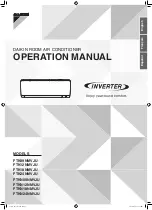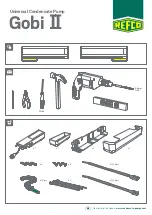
Vacuum Procedure
Important:
Use a quality Micron Gauge to measure and validate the system vacuum achieved.
Do not rely on the scale of a“bourbon tube”type gauge set to validate the depth and quality
of the vacuum.
1. Remove the caps of the liquid valve, gas valve and service port.
2. Connect gauge manifold and micron gauge to the service ports provided at the liquid and
suction service valves.
3. Connect a vacuum pump to the manifold gauge.
4. Open the lower pressure side of the manifold valve assembly and start the vacuum pump.
The switch at the high pressure side of the manifold valve assembly should be kept closed,
or evacuation does not fail.
5. Operate vacuum pump until a vacuum of 500 microns or less is achieved. The evacuation
duration depends on the vacuum pump size and unit’s capacity, generally 20 minutes for the
9,000 ButH units, to 1 hour for a larger 36,000 ButH unit.
6. Close the manifold valves and shut off the pump.
a. If vacuum holds below 700 microns for 15
minutes, the system can be considered dry
and leak free. Go to step 5.
b. If vacuum increases to 800 microns or greater,
this is an indication of moisture in system
or a leak exist. Identify leak and repair as
necessary, after which repeat steps 4 and 5.
If moisture is suspect, purge system use triple
evacuation method using dry nitrogen.
TESTING AND INSPECTION
Leak
Test
1.
Connect regulated nitrogen to manifold
. Attach
hose to service port.
2. Open
manifold
valve to add nitrogen to a pressure of 500 lbs.
3.
Maintain applied pressure for
30 minutes,
leak-test flare fittings with
soap bubbles. If no leak is
detected, release nitrogen.
CAUTION
Use vacuum pump, rather than refrigerant, to discharge air when installing the unit.
21
fig. 1










































